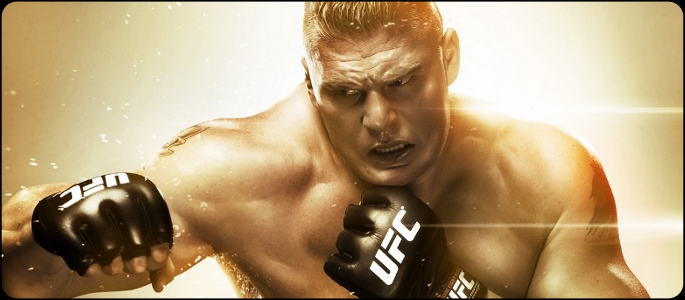
Last year, THQ released UFC 2009 Undisputed, garnering a large amount of critical acclaim and going on to sell over two million copies. The gameplay, in general, was fantastic, and really brought the feeling of the sport to gaming. It wasn’t just one of the best sports games of they year, but one of the best fighting games as well. It was so good that EA, who had previously turned the UFC down when approached to make a game based on the sport, felt the need to make their own MMA game to compete with the Yuke’s developed UFC title. When EA sports needs to scramble to catch up, it’s obvious that it was a job well done.
Sadly, the same accolades given to the gameplay couldn’t be applied across the board, as the title featured a number of problems when it came to the game modes. Most of the entertainment was found in sparring with other human opponents, and the game’s career mode simply wasn’t up to snuff. These flaws make UFC Undisputed 2010 all the more important, since the approaching EA Sports MMA would have some areas to attack. Luckily, Yuke’s has not only fixed a large number of problems with the combat, but also upped the ante when it comes to both presentation and gameplay modes, bringing the fight to a whole new level.
Despite being a stellar first-out, any UFC fan could list the flaws with 2009: the career mode was bare bones, the gameplay had some problems on the ground, the presentation needed work in a few areas, and there were some modes missing that fighting fans have come to expect from both sports and fighting games. This year, it’s as if Yuke’s went down that list, fixing every complaint.
UFC 2010 shows the largest improvements when it comes to the career mode, and the changes are evident immediately. Character creation has seen some enhancements, allowing players to not only add beards and long hair, but also choose from a list of first and last names that will be said by the announcers during the game. After creation, fighters enter the world of amateur fighting before graduating to the World Fighting Alliance, a league invented for the title. A few short matches later, and Dana White shows up to invite the fighter into the UFC, a proud moment in the life of any MMA fighter. It’s here, in the UFC, that the career mode begins to shine.

The interface might look the same, but there are some big changes under the hood. Players are allowed to customize their character’s move set by visiting fight camps. It’s here that they’re able to train specific abilities to add to their arsenal. Instead of simply selecting from pre-made templates, every single move can be changed, meaning players can pick and choose to make a character of their liking. Want Chuck Liddell’s left superman punch and Kimbo Slice’s right hook? Find a camp and train. Each move can be upgraded as well, meaning players can revisit gyms to make their abilities even stronger.
Keeping up on training is important, too, since stats actually degrade over time. Fighters have a long list of skills and abilities that need to be managed, and without proper care the player can be staring at a screen full of 0s. There are caps at 30, 50, and 70, and once they’re reached they’ll never drop below, but it takes time to get there, and constant training can become somewhat monotonous. It feels as though the caps should be more frequent, or the degradation slower, since it takes away from the fun of training new abilities when the old ones fall apart so quickly.
There are also issues with some of the random events that take place during the career, as they can often prove to take up more time than they’re worth. Being asked to pick the winners of an upcoming event is all good and well, but it becomes a chore when the game asks players to watch the computer-controlled bouts. THQ said that they received a huge demand to watch computers duke it out in UFC 2010, and while I can’t say it’s all that entertaining, there’s apparently an audience who would rather watch Undisputed than play it. It’s possible to exit out of the event after a few loading screens, but it seems like something that should have been handled better.
The same can be said about some of the other events, which ask the fighter to perform tasks in order to gain reputation. All of the details aren’t given until the event begins, and it’s common that there will be times where the fighter simply might not be able to do what is asked. A stand-up brawler could not have the skills to put someone in a submission, which means a few minutes spent futilely trying to wrestle with another fighter and a week wasted.
The events aren’t mandatory, however, and can be skipped altogether. They’re presented so well that it’s a shame, really, but it’s something that can be improved upon next year. Even with these minor issues, the good outweighs the bad, and the ability to really customize fighters is a great addition to Undisputed. These fighters can even be taken online and formed together into fight camps with friends, bringing the offline experience to a new level.

Other improvements to the career mode come in the presentation, which go a long way to making the act of building up a fighter even more rewarding. After getting into the UFC, Joe Rogan’s post-fight interviews are actually interactive, meaning players can shape not only their character’s body, but their personality as well. Giving cocky, demeaning answers can build up a fanbase quickly, while answering with sincere responses builds up reputation among the UFC. It’s even possible to call out other fighters, letting the player make a go at righting a previous wrong or going for the belt earlier than anticipated.
It all makes for a simply better experience for players that want to really live the UFC life in the game. For those who would rather just load up a pre-established UFC star, Title Mode and Title Defense Mode have been added. Yuke’s admitted that, while the previous game had a huge roster of UFC fighters, the fact that they couldn’t be played in any mode but expedition was to the game’s detriment. Now, players can pick a star and fight a gauntlet of foes in a mode that feels like classic tournaments of fighting games of yore, or a “lose and you’re out” mode that has the fighters retaining damage in-between fights. Both manage to feel completely UFC, while adding a lot of value to the package.
Other modes include a revamped “Ultimate Fights Mode” that allows players to relive classic fights in order to unlock items for career mode and footage of the actual fights. Last year, winning meant recreating the fight in every way. This year, there are three levels of challenges, each with increasingly difficult goals. To spice things up, the option to play as the loser and rewrite history is available. While it still maintains some of the elements that made the fight unique, the option is appreciated for those who would hate to see their favorite fighters lose a fight they think they should have won. On that same note, being able to create Pay-Per-View cards sees an introduction as well, as does the ability to download actual fight cards to play or watch.
Gameplay enhancements are abundant in Undisputed 2010. The octagon, an important element in UFC fighting that was neglected in 2009, is now a part of the fight. Pressing opponents against the cage adds another level of strategy and an entirely new set of moves, meaning players actually have a reason to keep their foes back to the wall. Being able to sway, too, should come as a pleasant surprise to players, and while it’s a bit difficult to pull off at first, the ability to dodge blows will surely find its way into competitive play among players willing to take time to learn proper techniques.
The only area where the gameplay suffers is when it comes to submissions, which returns to the Mario-party gameplay mechanic of spinning the stick until your palm is raw. “The shine”, as they call it, becomes frustrating quickly, and I’ll be happy when it’s removed and replaced with something based on skill, instead of skin-thickness.
Everything is deeper, with changes too numerous to count. Players will find that they’re taking advantage of the new mechanics without even noticing it, proving how well they’re integrated into the game. Little things, like being able to stomp on fighters’ feet when pressed against the cage and a fix to the annoying canned knock-out cinematics shown during replays take the level of polish to a new level.
For those picking the game up for the PlayStation 3, THQ has included a number of exclusive fighters. Royce Gracie, Jens Pulver, and Dan Severn are available for the picking, each fighting at the top of his game. Beyond that, there are a number of HD fights only to be found on the Blu-Ray disk, which is a great extra for any fan of the sport.
UFC 2009 was the king of a castle all to its own last year. Now, with EA bringing their own fighter to the octagon, THQ needed to step it up lest open themselves up to an attack. Luckily, they brought their A-game. 2010 is a fantastic title, with improvements in every area that needed it. While there are still flaws in a few areas that should be cleaned up for next year, there’s no denying that it’s simply a much better product. It might seem in poor taste to quote the trailer for EA Sports MMA in a review for the game’s competition, but there’s really no better way to describe what THQ has done with Undisputed 2010:
“Now it’s a fight.”
PlayStation LifeStyle’s Final Score
Cage-play adds a lot to the gameplay. Title and Title Defense Modes are surprisingly addictive. |
 |








